New ‘Meet the Press’ studio pays tribute to heart of democracy, free exchange of ideas
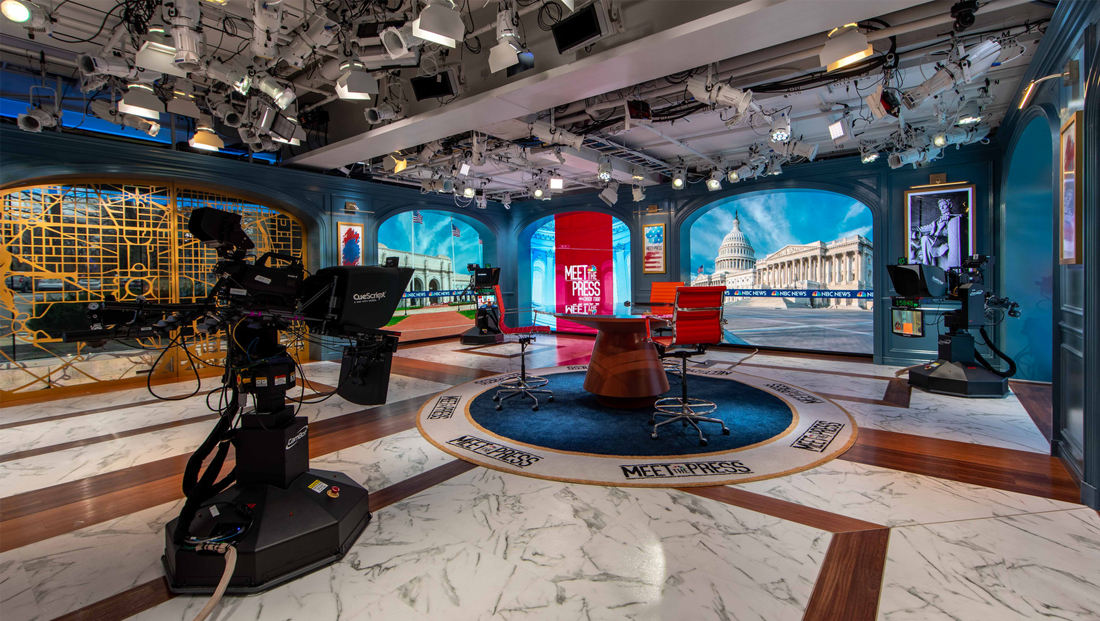
Subscribe to NCS for the latest news, project case studies and product announcements in broadcast technology, creative design and engineering delivered to your inbox.
Just like the city it calls home, the new studio of NBC News‘ “Meet the Press” explores the dichotomy of modern versus classical in a town that still leans heavily on storied traditions while coexisting in a world that’s constantly hitting refresh on the flow of information and conversation.
After over 60 years broadcasting from the studios of WRC, the network’s owned station in Washington, D.C., NBC execs made the pivotal decision to move “Meet the Press” and the network’s bureau closer to the heart of the city — paying credence to the mantra of “location, location, location.”
In the district, location is important — but so is “access, access, access” — so the network opted to start exploring ways to expand its downtown presence even before a January 2019 fire that heavily damaged its ancillary studios on the upper floors of the same office building the expanded new space is in.
The debut of “Meet the Press” from the space culminates a months long process of moving both on camera and behind the scenes areas across town.
Once the decision was made to create a new “hub” in the heart of the district and NBC secured the additional space inside the building, the network turned to the design team at HD Studio to fill the newly acquired real estate with multiple broadcast and work environments — including the ground-level studio for “Meet the Press.”
While Studio N5 on the eighth floor and the bureau newsroom on seven embrace clean lines and LED video walls so popular in broadcast studios today, the first floor is decidedly different.
NBCUniversal opens new D.C. bureau https://t.co/finx9EOVOU #TVNews #BroadcastNews
— TVNewsMix (@TVNewsMix) January 25, 2021
“We wanted to create a space … that speaks to NBCU News Group’s commitment to Washington-based coverage. It was important to us to balance the federal-style architecture with the unique modern finishes and latest technologies to break from the generic feel of many modern workspaces. Plus, creating expansive windows across the first floor studios and newsroom also reflects the importance of journalistic transparency,” said Marc Greenstein, SVP of design and production at NBC News and MSNBC.
To facilitate that concept, HD Studio’s team created a bit of a backstory about the new home for “Meet the Press” — it was a “found” space that had been expanded and modernized over time, noted Bryan Higgason.
“We always looked for ways to pit something very modern against something very classical,” he noted in an interview with NewscastStudio.
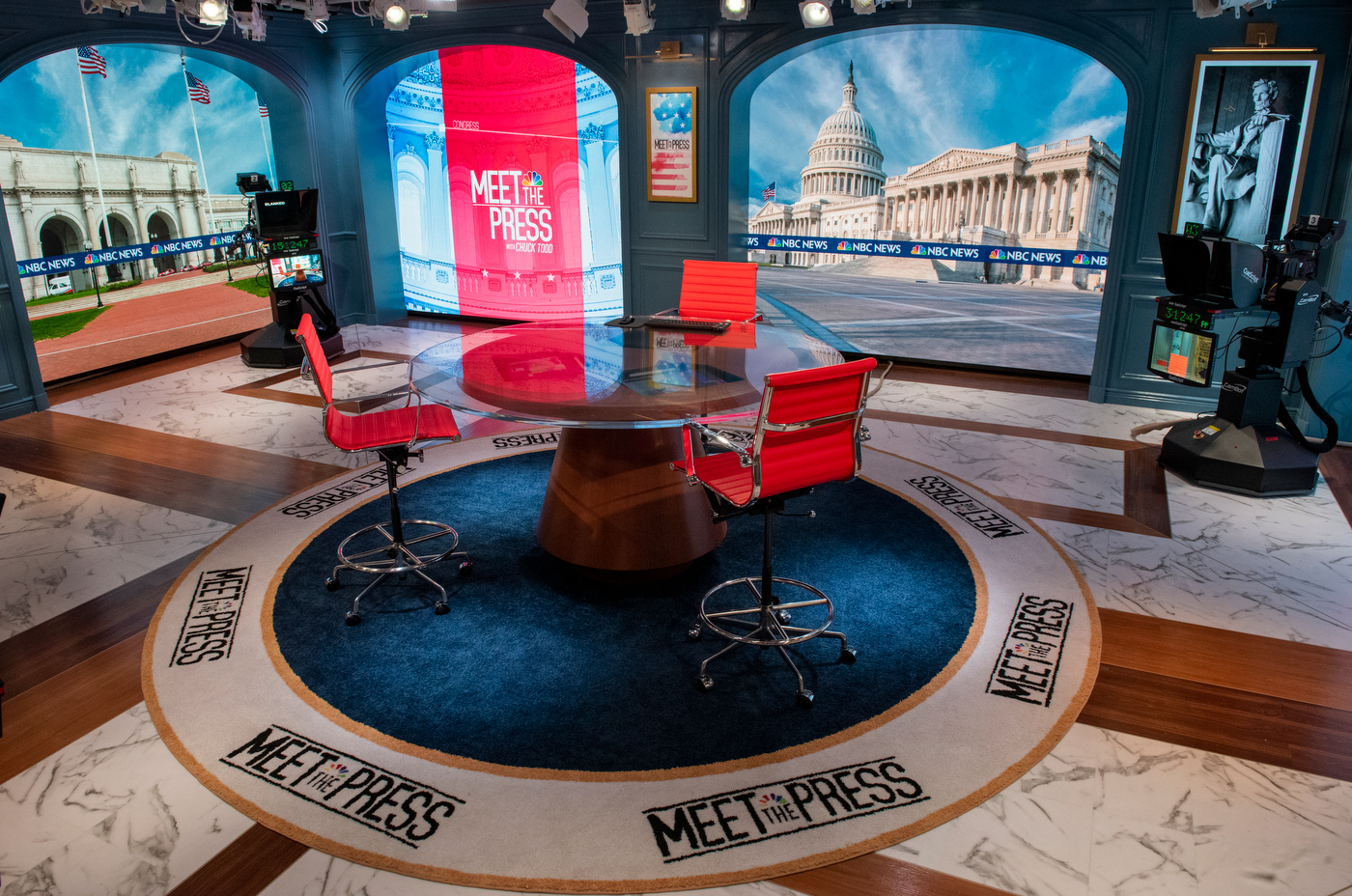

The ’roundtable’ area — most of the LED video walls in the archways can be moved to reveal real windows. Photos courtesy of Niel Galen and NBC News.
The main roundtable area for “Meet the Press” was enclosed with paneled walls and archways painted in a colonial blue discovered through research into historic architecture dating back to the founding of the country.
This gives it the basic structure of a traditional colonial room — complete with framed pictures and faux marble and wood floors.
In many ways, it’s sort of opposite the “open concept” that’s become all the rage in both home and office designs of today — but also a reflection of the design sensibilities of another era.
Not only does this go a long way in creating a perfect area for pointed questioning and interviews, but it’s a recognizable, consistent space viewers can expect to see each week.
These chats take place around a simple circular table with flared based sits on a circular custom carpet with the “Meet the Press” logo ringing it — somewhat reminiscent of another famous (albeit oval-shaped) area rug found elsewhere in the city (there’s also a generic NBC peacock version of the rug).
Though the pandemic will likely mean “MTP” has to rely on social distancing and remote interviews for the time being, the table is designed to sit up to four guests in addition to Chuck Todd and can be shot in the round.
HD Studio nixed the idea of using traditional hidden “camera ports” (disguised through open-backed bookshelves or dark corners of the studio) that are often mainstays of roundtable setups and instead paid close attention to blocking the camera positions as well as the evolving nature of the show’s format.
Cameras will still show up on air from time to time, but that’s also a nod to the connection to be old and new — and the flow of conversation from around that table out into the world, noted Higgason.
Meanwhile, the gently curving archways that box in this area are decidedly traditional but have the very modern option to be filled with seamless 1.56mm UHD LED panels from Neoti that can be used to showcase stylized imagery of D.C. landmarks or be used for remote interviews.
What’s not immediately visible, according to Higgason, is that all of these panels can be moved around behind the blue walls to reveal the real glass windows beyond as well as combined with an oversized, gold web-like sculptural gold map of Washington’s highly recognizable “spoke” street layout.
This configuration was inspired by Studio 1A in Rockefeller Center, which has its home base between two perpendicular walls of glass, giving the network a high profile “billboard” of its presence while also giving passersby a peek into the process of newsgathering.
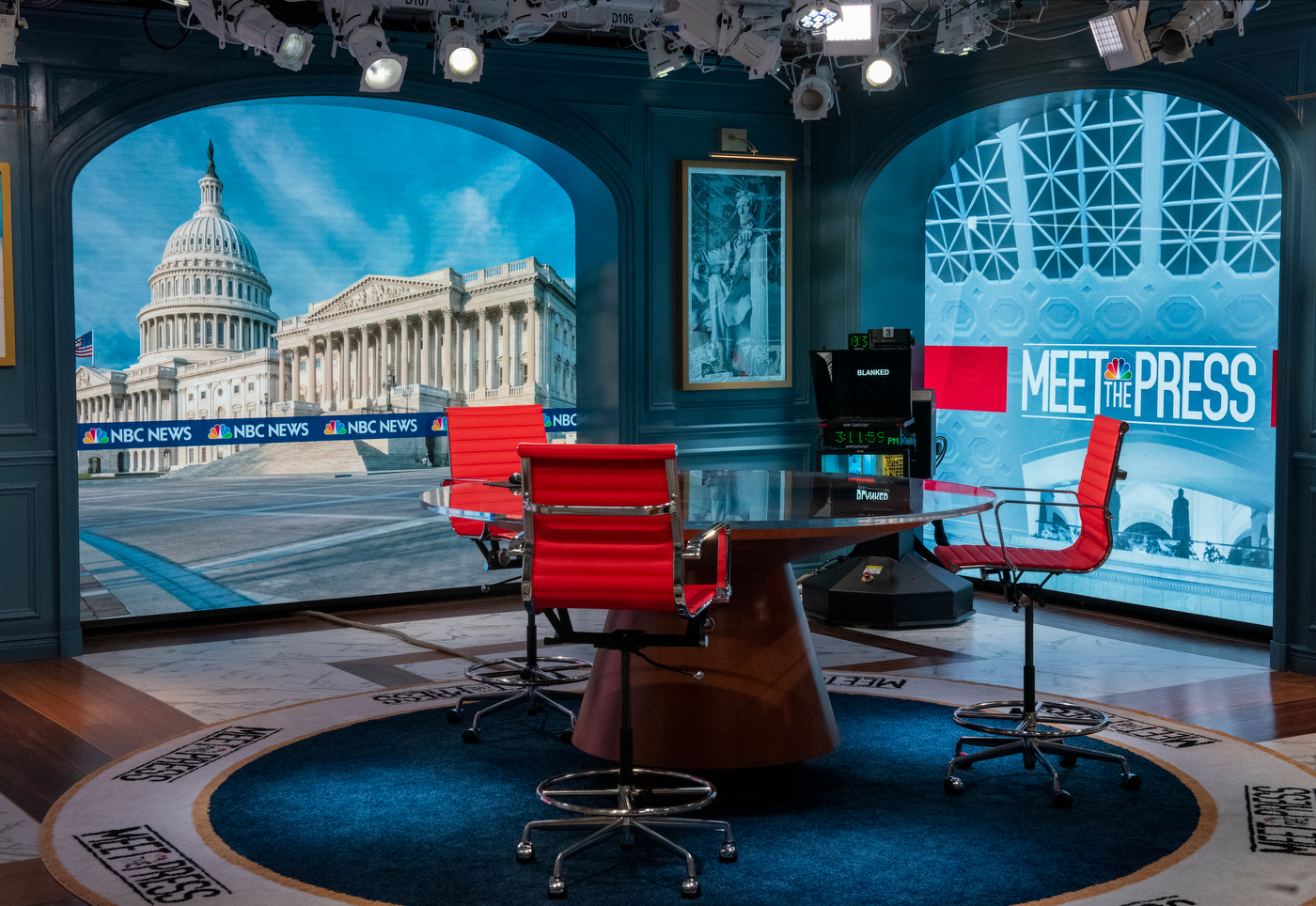

Just off this area is a more open, modern feeling “glass box” space with two perpendicular walls of glass overlooking the 45-workstation newsroom beyond, perhaps another nod to 1A.
The main desk in this space is another blend of old and new — its basic shape is that of a colonial or federalist style desk — with its gracefully bowed legs and other “carved” details.
However, it’s been finished in a bold bright red that’s found throughout the new D.C. facility as well as the network’s New York headquarters (and decidedly not very traditional).
It also includes integrated glass panels with color-changing LED edge lighting effects and frosted bars — another motif common found, for example, in the header element in the seventh-floor newsroom and throughout Studio N5 on eight.
While a truly antique piece could be emblazoned with a gold seal and leafing, this desk has custom, internal lit reveal lines and an NBC peacock in the center.
NBC's @chucktodd anchoring second #ImpeachmentDay coverage from part of the new Studio N1 in D.C. bureau. Full coverage & exclusive interview with design team coming soon! pic.twitter.com/ODW9wOzjGp
— NewscastStudio (@NewscastStudio) January 13, 2021
Shooting the red desk through one wall of windows gives viewers a dramatic view of an intricate barrel-vaulted ceiling with dark coffers that runs down the center of the newsroom, also inspired by neoclassical and federal architecture — a shot that started to show up during NBC and MSNBC coverage of the inauguration.
The rear wall of the newsroom is finished in the same bright red as the desk and equipped, directly behind the studio window, a 2×2 video panel array that provides a prominent digital canvas for branded or topical graphics behind various setups from the desk.
Interestingly, the designers didn’t set out with a red, white and blue color palette in mind for the space, said Higgason.
The team initially was more focused on integrating visual continuity to other NBC studios, but quickly discovered red went a long way in warming up the look — and it ended up being a great way to blend in a bit of that modern take on design with otherwise traditional looks.
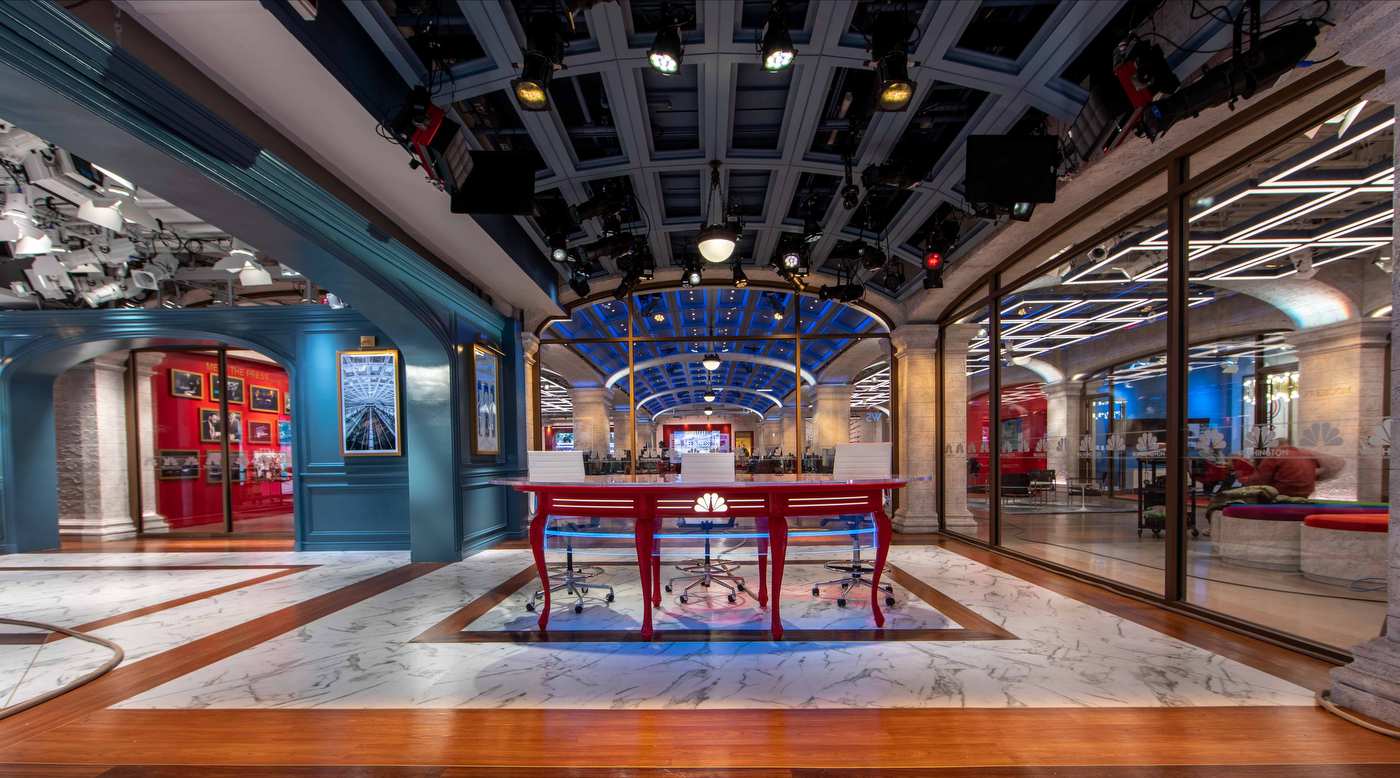

A more traditional anchor desk layout situated with glass on both sides and a dramatic barrel vault above.
Meanwhile, on either side of the central barrel vault is a more modern interpretation of that architectural element — suspended, internally lit rectangular frames arranged in grids, another example Higgason points out as a bridge between old and new.
The team also tucked thousands of LEDs in the coffers, cornices of columns and in other architectural details throughout the space, giving NBC the ability to create a multitude of moods and looks that spread beyond just studio lighting cues.
Getting these ceiling elements installed involved detailed work with HVAC and electrical contractors to get all of these systems as close to the structural ceiling as possible — giving the space the most possible using ceiling height (about 14 feet), said Higgason.
HD Studio also had to work around the numerous structural columns that hold the building up — which are spaced about every 20 feet or so in a grid pattern throughout the space. One, located in what would become the studio area, had to be relocated to create a larger footprint to work with.
Of course, columns are no stranger to neoclassical, federal-style architecture, so they were ultimately worked into the design.
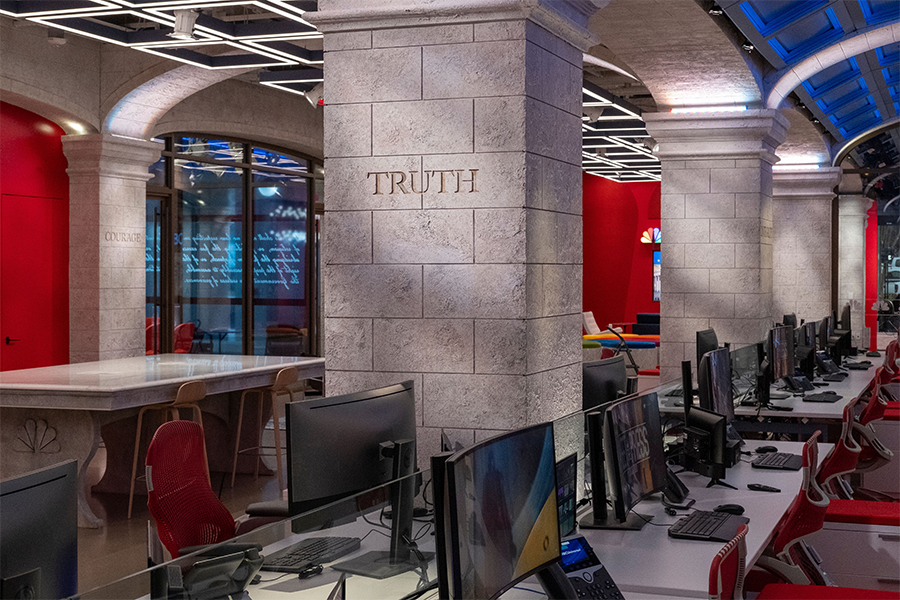

To refine the look, however, the columns were clad with a stone-like finish and “etched” with symbolic words such as “Honesty,” “Truth,” “Wisdom” and “Tenacity” — all meant to stand for, both literally and figuratively, the foundations on which journalism is based on.
“It felt important to provide reminders for what the people in that room do and speak to the qualities of the people delivering the news,” explained Higgason.
Staffers will also be able to look down for other reminders of their mission to facilitate conversation between the public and elected officials — numerous quotes about the free press and its relationship with the government are adhered to the floor.
One of the most obvious things about this text, however, is that it doesn’t line up with the rather grid-like layout of the rest of the space — instead, they’ve been aligned to roughly form spokes reaching out from the Capitol grounds.
“The idea is that the people in there are listening to what is emanating from that buildings,” said Higgason.
Also outside the studio is an open space that includes a combination of green room and gathering spaces for guests and workers alike.
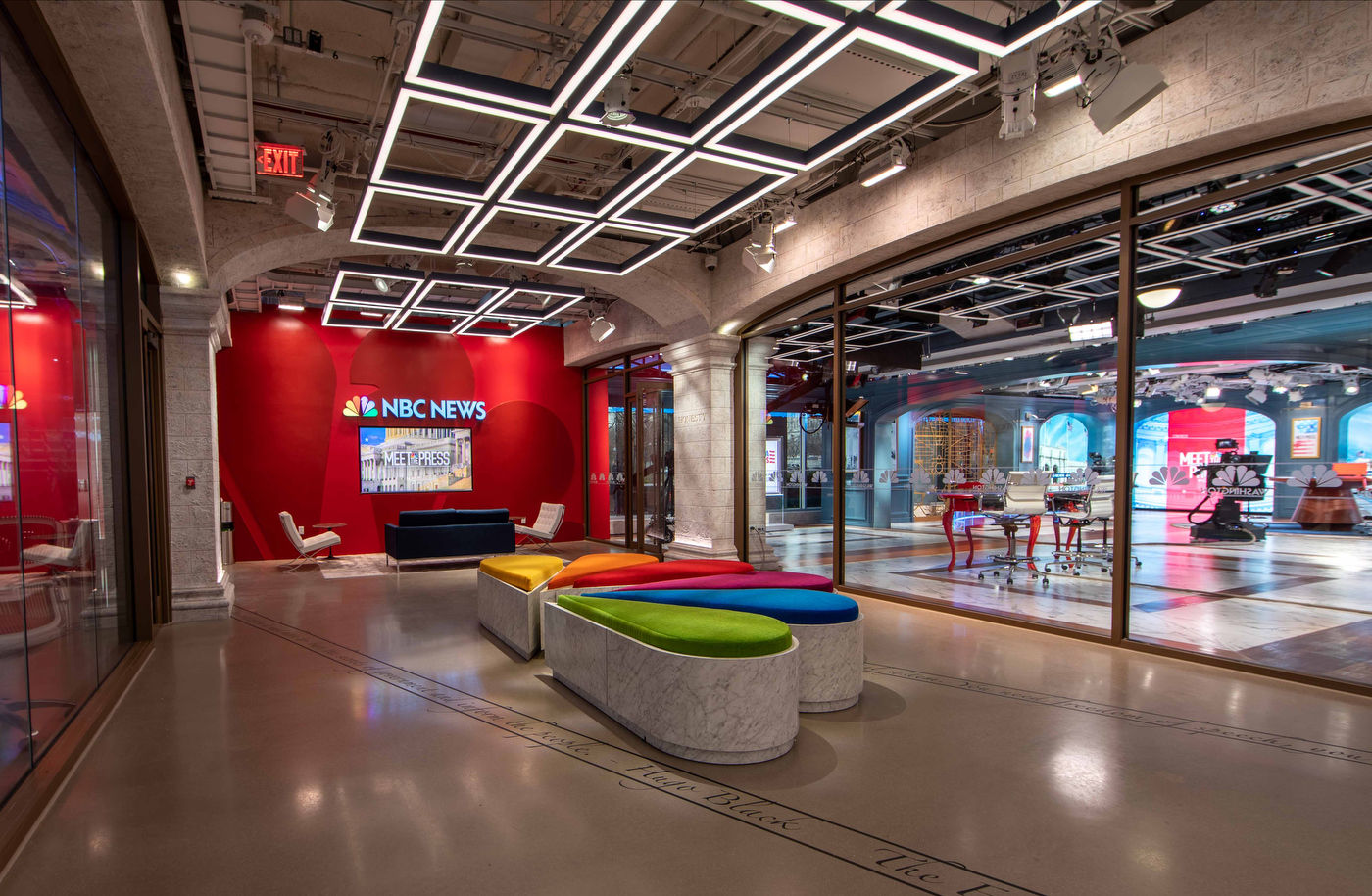

An open area outside the studio includes a green room and large NBC peacock ‘bench’ installation.
Rather than just rely on traditional seating, HD Studio came up with the idea to use a top-down view of the NBC peacock logo as a multifaceted seating area complete with faux marble bases.
Each “feather” is a separate segment of the installation and topped with one of the corresponding six colors found in the iconic logo.
Although COVID-19 likely means gathering in the area (as well as the other planned communal meeting areas throughout the newsroom) might not be leveraged right away, Higgason says it will be interesting to see how staffers and guests end up gravitating to it and sparking additional conversations.
“For more than seventy years, “Meet the Press” has been the place where presidents, policymakers, foreign leaders, and those in power have come to speak directly to American viewers,” said Todd. “This year, we will continue to be the gold standard of Sunday public affairs programming with the same sensibilities and mission, only now from a 21st-century studio with the latest technologies and broadcast capabilities.”
Project Credits
Set Design – Bryan Higgason, Paul Benson and Sid Wichienkuer of HD Studio
Lighting Design – Niel Galen of The Lighting Design Group
LED Displays – Neoti
Fabrication – blackwalnut
Systems Integrator – BeckTV
Subscribe to NCS for the latest news, project case studies and product announcements in broadcast technology, creative design and engineering delivered to your inbox.


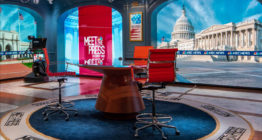




tags
BeckTV, Blackwalnut, Bryan Higgason, CueScript, HD Studio, Marc Greenstein, meet the press, NBC, NBC News, nbc washington, Neoti, newsroom studio, Niel Galen, Paul Benson, Ross CamBot, Sid Wichienkuer, Studio N1, The Lighting Design Group, washington, washington d.c.
categories
Broadcast Design, Broadcast Facility, Broadcast Industry News, Exclusives, Heroes, News Set Design, Set Design